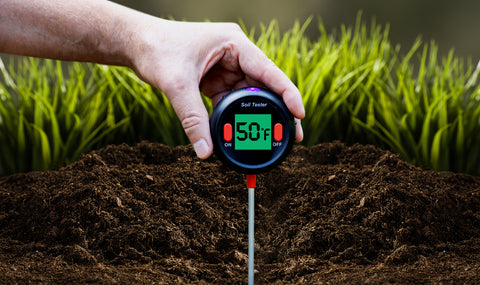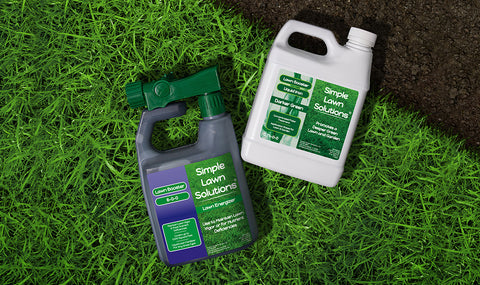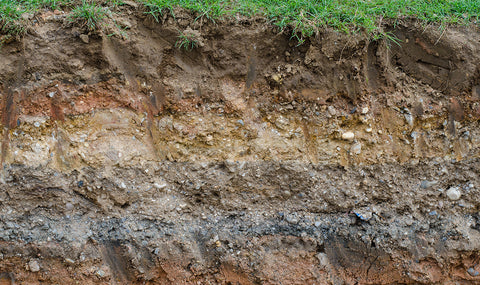The age-old question around every spring - is it time to fertilize my lawn? Essential nutrients are required to initiate the plant's absorption of the critical elements to grow and produce oxygen for the environment. However, most fail to perform this easy task, determining what fertilization program will be required for a healthy start in spring.
Soil test results should be used to determine if there are any deficiencies and how much of a particular nutrient is available to the turfgrass plant. Sure, soil temps are essential because the grass will become active and begin to grow, but if there isn’t a defined plan to supply the soil with what it needs to feed the plant, your lawn could become toxic and out of balance to grow correctly.
The Best Soil Temperature to Start Fertilizing
The best temperature to start a fertilization program for lawns and turfgrass is just before the soil temps reach 50-55 degrees. Timing is sensitive because any warmer than 55 degrees, weed seeds germinate. Therefore, the fertilization program should start when soil temps reach 50 degrees.

It is best to have nutrients in the root zone profile before initial growth. Waiting until the soil temps are optimum for growth to apply fertilizer is too late. Additionally, fertilizers with preemergent herbicides must be used before weed seed germination.
Why is Adequate Moisture Required
With the proper moisture in the soil, nutrients will break down enough for roots to absorb the applied nutrients. Soil compaction will slow the infiltration rate through the soil profile and remain on the top layer or in thatch. Creating openings through the thatch layer and into the soil assists in moving the nutrients downward for plant feeding. Core aeration opens compacted soil so the process can take place.
Liquid fertilizers have an advantage over granular fertilizers because less time is required for breakdown and are more readily absorbed. Some liquid fertilizers such as Darker Green Liquid Iron Fertilizer and Lawn Booster: Lawn Energizer Nitrogen and Iron Liquid Fertilizer, are not watered in but rather absorbed directly through the leaf blades and display enhanced color and vigor. Other fertilizers do require irrigation to move into the soil. Regardless of the fertilizer type, soil moisture is the key to seeing results.

Over-fertilization
Over-fertilization occurs a lot in lawns and turfgrass, especially when soil tests are not performed, and assumptions are made. If over-application occurs consecutively each season, the pH in the soil is altered, and critical nutrients such as nitrogen and phosphorous cannot dissolve and become unavailable to the root system. Additionally, over-fertilization increases the salt content within the soil and kills beneficial microorganisms required to complete biological functions for turfgrass and other plants.
High salt content within the soil will cause roots to become shallow, display unwanted stress, and even die. Spilling large amounts of fertilizer on the surface of your lawn will probably burn and kill plant tissue and forever contaminate the soil. To correct this problem, the soil must be removed to a 6” depth and replaced for the safety of future growth. Fertilizers of overabundance on the surface and within the soil can translocate by surface runoff. Runoff contaminates water and soil, where toxins settle in lakes, ponds, streams, and low-elevation lands.

The Best Time To Fertilize
There are vital signs within the environment indicating when it is time to fertilize and begin the season. Forsythia blooms with bright yellow flowers in late winter or early spring. This is a good indicator that your lawn is ready to eat. Timing is critical when fertilizing with pre-emergent combined.
It is recommended to fertilize earlier so the nutrients are available before the turfgrass initiates top growth and root activity. Most reserved energy can be depleted if nutrients are unavailable when it is time to eat for the grass. This can affect how turf handles stresses during the growing season. So, applying when soil temps reach 50 degrees is a beneficial practice so your lawn has food to eat and before germination of crabgrass and other weeds, which requires the soil temp to be 60-62 degrees at 1”-2” depth.
How Soil Type Affects Fertilization Frequency
The frequency of fertilization applications depends on what type of soil the lawn or turfgrass is growing in. Sandy soils have a higher leaching and infiltration rate than other soil types. Loamy soils are excellent for lawns because they are balanced to hold nutrients longer and retain the right amount of moisture under normal circumstances. This soil type is also more forgiving if the lawn doesn’t receive enough water or nutrients, as it holds these materials longer than sandy soils.
Clay and silt soils are most sensitive to the amount of water and nutrients applied. There is certainly less room for error in adding too much and not adding enough. Nutrient and water retention are held many times longer than other soil types. It is easy to over-fertilize high clay-content soils and excessive watering can produce more runoff.

Determining the soil type you may have is another great reason for soil testing. Additional soil testing can be performed to determine particle size, infiltration rate, and organic content if desired. The more information one has about the soil and its needs, the more a sign of success for future growth.
Fertilization Timing Procedure
First, keep an eye on environmental indicators like the blooming of Forsythia. Soil thermometers are available and are very reliable in indicating the soil temperature. Following the recommendations of your soil test results, apply what nutrients are needed in the soil.

Best Practices When Fertilizing
Over-fertilization causes soil to become toxic for plant life. Soil moisture content and irrigation operation are crucial to breaking down the nutrients available to roots and turf tissue. Once fertilization occurs, be patient and allow Mother Nature to take control of your lawn.
Regular maintenance is done by following the 1/3 rule in mowing. Growth will accelerate, and your mowing frequency will likely increase to maintain a professional image. Repeat fertilization applications every 1 – 2 months during the growing season and based on the soil type within which your lawn or turfgrass is growing.
In conclusion, proper fertilization of lawns and turfgrass is essential for healthy growth, but it requires careful consideration of soil type, temperature, and moisture levels. Soil testing is crucial to determine nutrient deficiencies and avoid over-fertilization, which can harm the soil and plant life. Timing fertilization based on environmental indicators and soil temperature, along with regular maintenance and adherence to soil type-specific fertilization schedules, ensures optimal lawn health and sustainability. Patience, along with a balanced approach to fertilization, allows for the natural growth and maintenance of a vibrant lawn ecosystem










1 comment
I live in Salem Oregon (Zone 8). Which fertilizer do you recommend using in Spring?